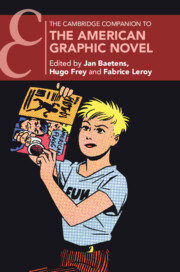Book contents
- The Cambridge Companion to the American Graphic Novel
- The Cambridge Companion to the American Graphic Novel
- Copyright page
- Contents
- Figures
- Contributors
- Editors’ Acknowledgments
- Introduction
- Part I History and Genre
- 1 The “First” Graphic Novel in America
- 2 The Mad-Men Generation
- 3 From Justin Green and Art Spiegelman to Alison Bechdel
- 4 Graphic Journalism
- 5 “Great” American Graphic Novels
- 6 Crime
- 7 Superheroes in Graphic Novels
- 8 Science Fiction and Fantasy
- 9 “Scared Witless”
- Part II Graphic Novels and the Quest for an American Diversity
- Index
- Cambridge Companions To …
- References
4 - Graphic Journalism
from Part I - History and Genre
Published online by Cambridge University Press: 10 January 2024
- The Cambridge Companion to the American Graphic Novel
- The Cambridge Companion to the American Graphic Novel
- Copyright page
- Contents
- Figures
- Contributors
- Editors’ Acknowledgments
- Introduction
- Part I History and Genre
- 1 The “First” Graphic Novel in America
- 2 The Mad-Men Generation
- 3 From Justin Green and Art Spiegelman to Alison Bechdel
- 4 Graphic Journalism
- 5 “Great” American Graphic Novels
- 6 Crime
- 7 Superheroes in Graphic Novels
- 8 Science Fiction and Fantasy
- 9 “Scared Witless”
- Part II Graphic Novels and the Quest for an American Diversity
- Index
- Cambridge Companions To …
- References
Summary
This chapter examines the nonfiction subgenre of graphic journalism or visual reportage. It first presents the major forerunners of the genre, including Kurtzman, Crumb, and Brabner and Merkle, then further addresses the characteristics of such graphic works from three perspectives: history, documentary, and authorial presence. The analysis of “history” highlights the difference between journalism as a report on recent, noteworthy events and the more distanced view presented in the graphic novel, which requires extensive research and comes much after the time of the events, thereby adding a historical perspective often lacking in journalism, even when the graphic works include a witness account of the authors themselves, as in Joe Sacco’s work, typically. The chapter studies the “documentary” aspect through the effort to represent the experience of others, with particular attention to the encounter between authors and cultural others. Finally, the chapter examines the pivotal role of the graphic “author-journalist” as curator and sometimes character in their own reportage, either directly (Delisle) or in more understated forms (Backderf).
Keywords
- Type
- Chapter
- Information
- The Cambridge Companion to the American Graphic Novel , pp. 72 - 88Publisher: Cambridge University PressPrint publication year: 2023



